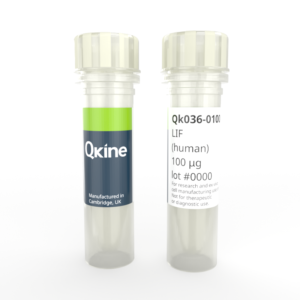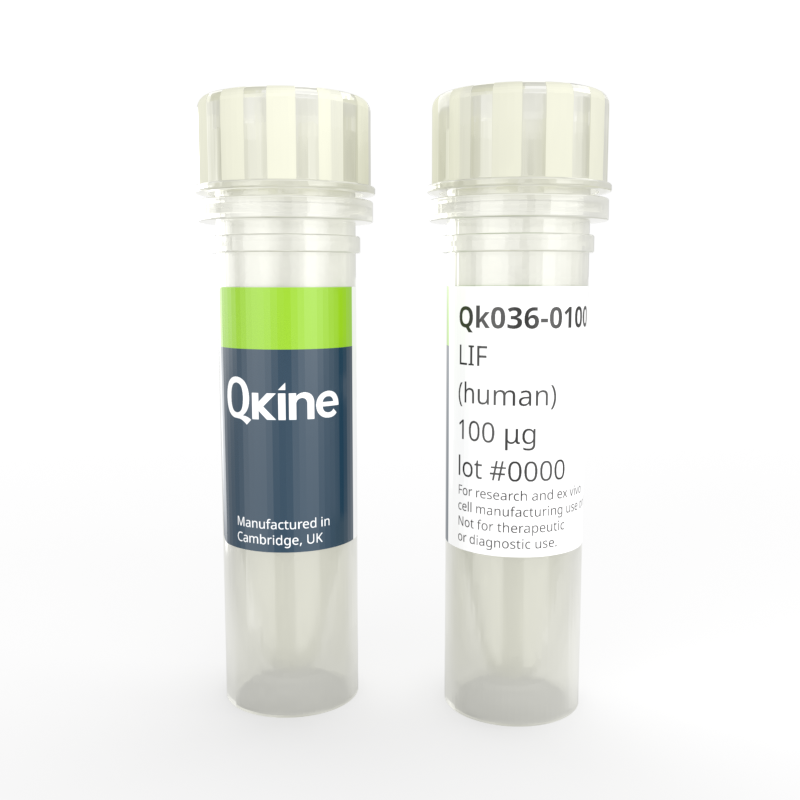 Recombinant human LIF protein (Qk036)
Recombinant human LIF protein (Qk036)Recombinant human LIF protein (Qk036)
Price range: £175.00 through £1,900.00
Human LIF (leukemia inhibitory factor) suppresses the differentiation of murine embryonic stem cells (ESCs) and is widely used in ESC and induced pluripotent stem cell (iPSC) culture.
Qkine human LIF protein is a 17 kDa highly pure, bioactive, animal origin-free and carrier-protein free for reproducible results in stem cell culture.
In stock
Orders are typically shipped same or next day (except Friday).
Easy world-wide ordering, direct or through our distributors.
Price range: £175.00 through £1,900.00
Buy online with secure credit card or purchase order. For any questions, please email orders@qkine.com
Summary:
- High purity human LIF protein (Uniprot: P15018)
- 17 kDa
>98%, by SDS-PAGE quantitative densitometry
Expressed in E. coli
Animal origin-free (AOF) and carrier protein-free
Manufactured in our Cambridge, UK laboratories
Lyophilized from acetonitrile, TFA
- Resuspend in 10 mM HCl (Reconstitution solution A) at >50 µg/ml, add carrier protein if desired, prepare single-use aliquots and store frozen at -20 °C (short-term) or -80 °C (long-term)
Featured applications:
Propagation of embryonic stem cells in feeder or feeder-free chemically defined culture systems
Human LIF can be used in the maintenance of murine ESCs

Human LIF activity was determined using the LIF-responsive firefly luciferase reporter assay. HEK293T cells were treated in triplicate with a serial dilution of LIF overnight. Firefly luciferase activity was measured and normalised to the control Renilla luciferase activity. EC50 = 16.8 pM (0.29 ng/mL). Data from Qk036 lot #104293.
Human LIF protein (Qk036) migrates as a single band at 20 kDa in non-reducing (NR) and upon reduction (R). Purified recombinant human LIF protein (3 μg) was resolved using 15% w/v SDS-PAGE in reduced (+β-mercaptoethanol, R) and non-reduced conditions (NR) and stained with Coomassie Brilliant Blue R250. Data from Qk036 lot #104293.

Further quality assays
Mass spectrometry: single species with expected mass
Recovery from stock vial: >95%
Endotoxin: <0.005 EU/μg protein (below level of detection)
We are a company founded and run by scientists to provide a service and support innovation in stem cell biology and regenerative medicine. All our products are exceptionally high purity, with complete characterisation and bioactivity analysis on every lot.

Qkine human LIF is as biologically active as the comparable alternative supplier protein. Quantitative luciferase assay with Qkine LIF (Qk036, green) and alternative supplier LIF (Supplier B, black). Cells were treated in triplicate with a serial dilution of LIF for 24 hours. Firefly luciferase activity was measured and normalized to control Renilla luciferase activity.
Technote | LIF (Qk036) bioactivityProtein background
LIF is a pleiotropic factor that belongs to the IL-6 superfamily of cytokines. LIF is expressed as a 202 amino acid precursor which is processed by the removal of 22 animo acids from the N-terminus, which is important for receptor binding [1]. LIF acts through the heterodimeric receptor of LIFR (gp190)/gp130 [1, 2]. Although this receptor is shared by other cytokines, LIF stands out as it can have opposite effects depending on cell type, either stimulating or inhibiting cell proliferation and differentiation. LIF activates several cellular signaling pathways including the JAK/STAT, PI3K and MAPK pathways [1].
LIF signaling is essential for maintenance of murine ESC pluripotency through STAT3 signaling [2]. In neural stem cell (NSC) culture LIF can have complex and potentially contradictory effects. LIF enhances NCS self-renewal but can also promote gliogenesis, depending on the context and presence of other growth factors, such as epidermal growth factor (EGF) and fibroblast growth factor 2 (FGF-2) [3].
Human LIF can be used for the maintenance of mouse embryonic stem cells, however mouse LIF cannot bind to the human receptor, thus rendering mouse LIF inactive on human cells [4].
Publications using Recombinant human LIF protein (Qk036)
-
A mosaic gastruloid model highlights the developmental stage-specific restriction of cell competition in mammalian pre-gastrulation
Frenster JD, Babin S, Josende Garcia JB et al.
DOI: https://doi.org/10.1101/2025.01.25.634859 -
ERK signalling eliminates Nanog and maintains Oct4 to drive the formative pluripotency transition
Mulas C, Stammers M, Salomaa SI, Heinzen C, Suter DM, Smith A, Chalut KJ.
DOI: doi: 10.1242/dev.203106 -
Esrrb guides naive pluripotent cells through the formative transcriptional programme
Carbognin E, Carlini V, Panariello F et al.
DOI: doi: 10.1038/s41556-023-01131-x -
Feeder-free culture of naive human pluripotent stem cells retaining embryonic, extraembryonic and blastoid generation potential
Rossignoli G, Oberhuemer M, Brun IS et al.
DOI: https://doi.org/10.1101/2025.01.17.633522 -
Generating human blastoids modeling blastocyst-stage embryos and implantation
Heidari Khoei H, Javali A, Kagawa H et al.
DOI: doi: 10.1038/s41596-023-00802-1 -
Genome-wide screening in pluripotent cells identifies Mtf1 as a suppressor of mutant huntingtin toxicity
Ferlazzo GM, Gambetta AM, Amato S et al.
DOI: doi: 10.1038/s41467-023-39552-9 -
KLF7 is a general inducer of human pluripotency
Arboit M, Zorzan I, Pellegrini M et al.
DOI: https://doi.org/10.1101/2023.09.06.556189 -
Self-renewing human naïve pluripotent stem cells dedifferentiate in 3D culture and form blastoids spontaneously
Guo M, Wu J, Chen C et al.
DOI: doi: 10.1038/s41467-024-44969-x -
STAT3 and HIF1α cooperatively mediate the transcriptional and physiological responses to hypoxia
Dinarello A, Betto RM, Diamante L et al.
DOI: doi: 10.1038/s41420-023-01507-w -
Inhibition of PRC2 enables self-renewal of blastoid-competent naive pluripotent stem cells from chimpanzee
Huang, T et al.
DOI: DOI: 10.1016/j.stem.2025.02.002 -
α-Ketoglutarate promotes trophectoderm induction and maturation from naive human embryonic stem cells
Van Nerum, K., Wenzel, A., Argemi-Muntadas, L. et al.
DOI: doi.org/10.1038/s41556-025-01658-1 -
Signaling reprogramming via Stat3 activation unravels high-fidelity human post-implantation embryo modeling
Chen C, Wu J, Wang X et al.
DOI: DOI: 10.1016/j.stem.2025.08.011
FAQ
Leukemia inhibitory factor (LIF) is an interleukin 6 class cytokine, named for its ability to induce the terminal differentiation of myeloid leukemia cells.
In the early developing embryo, LIF is expressed in the trophectoderm.
LIF binds to the heterodimeric receptor LIFR (gp190)/gp130.
LIF activates several cellular signaling pathways including the JAK/STAT, PI3K and MAPK pathways.
LIF can be added to feeder-free stem cell cultures, it promotes self-renewal by recruiting signal transducer and activator of transcription 3 (Stat3).
Our products are for research use only and not for diagnostic or therapeutic use. Products are not for resale.
For use in manufacturing of cellular or gene therapy products. Not intended for in vivo applications.

Receive an Amazon gift voucher when you leave us a review.
£25, $30 or €30 for reviews with an image and £10, $15 or €15 for reviews without an image
